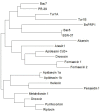(Re)Defining the Proline-Rich Antimicrobial Peptide Family and the Identification of Putative New Members
- PMID: 33335890
- PMCID: PMC7736402
- DOI: 10.3389/fchem.2020.607769
(Re)Defining the Proline-Rich Antimicrobial Peptide Family and the Identification of Putative New Members
Abstract
As we rapidly approach a post-antibiotic era in which multi-drug resistant bacteria are ever-pervasive, antimicrobial peptides (AMPs) represent a promising class of compounds to help address this global issue. AMPs are best-known for their membrane-disruptive mode of action leading to bacteria cell lysis and death. However, many AMPs are also known to be non-lytic and have intracellular modes of action. Proline-rich AMPs (PrAMPs) are one such class, that are generally membrane permeable and inhibit protein synthesis leading to a bactericidal outcome. PrAMPs are highly effective against Gram-negative bacteria and yet show very low toxicity against eukaryotic cells. Here, we review both the PrAMP family and the past and current definitions for this class of peptides. Computational analysis of known AMPs within the DRAMP database (http://dramp.cpu-bioinfor.org/) and assessment of their PrAMP-like properties have led us to develop a revised definition of the PrAMP class. As a result, we subsequently identified a number of unknown and unclassified peptides containing motifs of striking similarity to known PrAMP-based DnaK inhibitors and propose a series of new sequences for experimental evaluation and subsequent addition to the PrAMP family.
Keywords: 70S ribosome; AMPs; DnaK; PrAMP; antimicrobial peptides; host defense peptides; proline-rich antimicrobial peptide.
Copyright © 2020 Welch, Li, Hossain, Separovic, O'Brien-Simpson and Wade.
Conflict of interest statement
The authors declare that the research was conducted in the absence of any commercial or financial relationships that could be construed as a potential conflict of interest.
Figures




Similar articles
-
Evaluation of Potential DnaK Modulating Proline-Rich Antimicrobial Peptides Identified by Computational Screening.Front Chem. 2022 Apr 13;10:875233. doi: 10.3389/fchem.2022.875233. eCollection 2022. Front Chem. 2022. PMID: 35494637 Free PMC article.
-
Intracellular Antimicrobial Peptides Targeting the Protein Synthesis Machinery.Adv Exp Med Biol. 2019;1117:73-89. doi: 10.1007/978-981-13-3588-4_6. Adv Exp Med Biol. 2019. PMID: 30980354 Review.
-
Proline-Rich Antimicrobial Peptides from Invertebrates.Molecules. 2024 Dec 12;29(24):5864. doi: 10.3390/molecules29245864. Molecules. 2024. PMID: 39769953 Free PMC article. Review.
-
Fragments of the Nonlytic Proline-Rich Antimicrobial Peptide Bac5 Kill Escherichia coli Cells by Inhibiting Protein Synthesis.Antimicrob Agents Chemother. 2018 Jul 27;62(8):e00534-18. doi: 10.1128/AAC.00534-18. Print 2018 Aug. Antimicrob Agents Chemother. 2018. PMID: 29844040 Free PMC article.
-
Computer-aided design of proline-rich antimicrobial peptides based on the chemophysical properties of a peptide isolated from Olivancillaria hiatula.J Biomol Struct Dyn. 2023 Oct-Nov;41(17):8254-8275. doi: 10.1080/07391102.2022.2131626. Epub 2022 Oct 11. J Biomol Struct Dyn. 2023. PMID: 36218088
Cited by
-
Characterization of New Defensin Antimicrobial Peptides and Their Expression in Bed Bugs in Response to Bacterial Ingestion and Injection.Int J Mol Sci. 2022 Sep 29;23(19):11505. doi: 10.3390/ijms231911505. Int J Mol Sci. 2022. PMID: 36232802 Free PMC article.
-
Designing New Hybrid Antibiotics: Proline-Rich Antimicrobial Peptides Conjugated to the Aminoglycoside Tobramycin.Bioconjug Chem. 2023 Jul 19;34(7):1212-1220. doi: 10.1021/acs.bioconjchem.2c00467. Epub 2023 Jun 28. Bioconjug Chem. 2023. PMID: 37379329 Free PMC article.
-
Host-Bacterial Interactions: Outcomes of Antimicrobial Peptide Applications.Membranes (Basel). 2022 Jul 19;12(7):715. doi: 10.3390/membranes12070715. Membranes (Basel). 2022. PMID: 35877918 Free PMC article. Review.
-
Sequence-activity mapping via depletion reveals striking mutational tolerance and elucidates functional motifs in Tur1a antimicrobial peptide.Protein Eng Des Sel. 2024 Jan 29;37:gzae006. doi: 10.1093/protein/gzae006. Protein Eng Des Sel. 2024. PMID: 38484121 Free PMC article.
-
Designing New Chimeric Proline-Rich Antimicrobial Peptides to Enhance Efficacy Toward the ESKAPE+E: Beyond Sequence Extension.Biomolecules. 2025 May 27;15(6):776. doi: 10.3390/biom15060776. Biomolecules. 2025. PMID: 40563417 Free PMC article.
References
-
- Agerberth B., Lee J. Y., Bergman T., Carlquist M., Boman H. G., Mutt V., et al. . (1991). Amino acid sequence of PR-39. Isolation from pig intestine of a new member of the family of proline-arginine-rich antibacterial peptides. Eur. J. Biochem. 202, 849–854. 10.1111/j.1432-1033.1991.tb16442.x - DOI - PubMed
-
- Bower M. A., Cudic M., Campbell W., Wade J. D., Otvos L. (2003). Walking the fine line between intracellular and membrane activities of antibacterial peptides. Lett. Peptide Sci. 10, 463–473. 10.1007/BF02442578 - DOI
-
- Bulet P., Dimarcq J. L., Hetru C., Lagueux M., Charlet M., Hegy G., et al. . (1993). A novel inducible antibacterial peptide of Drosophila carries an O-glycosylated substitution. J. Biol. Chem. 268, 14893–14897. - PubMed
LinkOut - more resources
Full Text Sources
Research Materials
Miscellaneous

